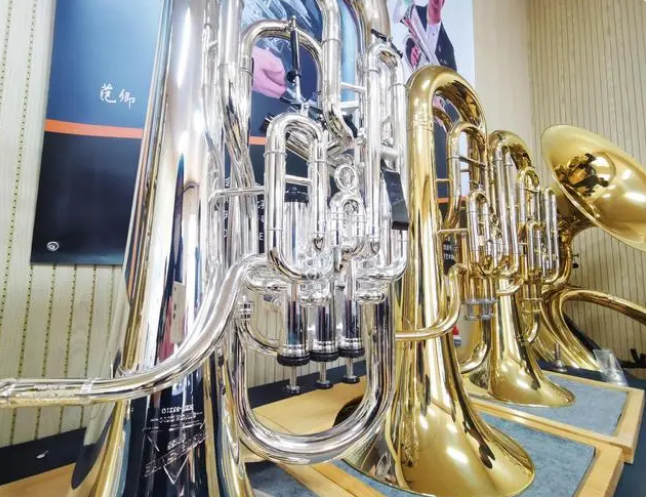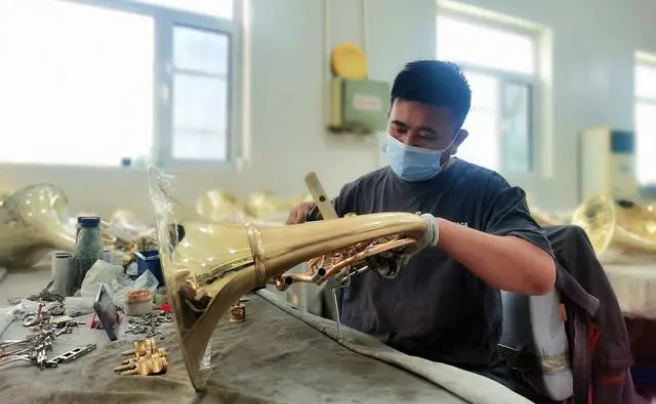
Known as the “saxophone capital of China,” more than half of the world’s saxophones are produced in Sidangkouzhong Village, Caigongzhuang Town, Jinghai District, Tianjin Municipality. Approximately 80% of the adults in the village of 2,200-plus people work in the local musical instrument industry, which also includes the manufacture of various other Western instruments, such as trumpets, flutes and clarinets, around 80% of the instruments that are produced are exported, and approximately RMB300 million of total annual output value was being created as of 2021.
Musical Instruments Generate Respectable Income
Sidangkouzhong’s musical instrument industry has gradually grown and developed over the decades. In the 1970s, a small factory that produced components for a larger musical instrument factory based elsewhere in Tianjin was established, which gave locals an opportunity to increase their incomes.
In the 1980s, more factories were built in the village, and they mostly produced trumpets. In the 1990s, the factories mostly began producing saxophones due to the growing popularity of the instrument around the world.
In the 2000s, greater numbers of the village’s inhabitants got involved with the musical instrument industry, and more than a dozen factories emerged, including one owned and operated by Tianjin Oves Musical Instrument Co. Ltd., which became the largest in the village. Residents have been obtaining stable work and earning respectable incomes as they have gotten involved with the industry and it has grown and developed.
Tending to follow in their parents’ footsteps, Sidangkouzhong’s young people often pursue musical instrument production and craftsmanship when they graduate from secondary school.
Members of younger generations have also been engaging in e-commerce and helping to develop it in the village. Most of the 400 households in its borders operate online stores and e-commerce has accounted for up to 40% of its total output value as of early 2021. Sidangkouzhong has become a well-known Taobao Village, which refers to a village in which more than 10 percent of families are actively engaged in e-commerce or where there are at least 100 active online stores and total online sales exceed RMB10 million (US$1.56 million) per year. Young people have been launching stores on the Taobao online shopping platform and engaging in livestreaming in order to increase domestic instrument sales, which accounts for about a third of the village’s musical instrument output value as of 2021 and is largely dependent on e-commerce. Accounting for the remaining two-thirds, or a minimum of around RMB40 million to RMB50 million a year, the international market is very important for the village and involves export to countries and regions such as Europe, the U.S. and Southeast Asia.
Other Western instruments are mass produced in Sidangkouzhong as well. Oves Instrument Company has been producing tubas since 2010 for example. Designing and fabricating production equipment was a slow process and cost five times as much as it did for the saxophones that they produce due to the complex curvature that needs to be created, however. In 2021, owner Zhang Guomin noted that it took three months to develop bending machinery and motorise it properly and that two years of overall research and development (R&D) occurred until a tuba product finally took shape during an interview at his company. He also explained that producing curvature is a half-month-long process involving repeated quenching, hammering and hydraulic pressing. The village ultimately gained the ability to export dozens per month, which was very beneficial due to the fact that greater profit is achieved exporting 1 tuba than 100 saxophones. Producing high-end instruments contributed to Zhang’s business being able to export nearly 100,000 wind instruments, achieve nearly RMB90 million of annual output value, and become one of the leading enterprises in the village in 2019.
Developing the Musical Instrument Industry
According to a report on musical instrument development in China that was released in 2019, the country is the world’s largest producer and exporter of musical instruments, creates the greatest output value in this area, and produces the greatest number of different types of instruments but mostly does not produce high-end instruments and lags far behind developed countries in terms of its capacity for production innovation. Musical instrument manufacturing in China’s towns and villages tends to be quite labour- and resource-intensive, and many of the people who are in charge of instrument factories do not have a good understanding of music. Instruments have tended to be viewed simply as products to be sold rather than works of art suitable for performance on the stage. It is thus crucial to cultivate skilled technicians with a high degree of musical literacy and other instrument manufacturing talent.
Sidangkouzhong has tended to be typical of China’s overall musical instrument production situation. Hailing from rural areas and generally not having received music education, the village’s instrument producers have mostly been unable to properly inspect and calibrate the instruments that they produce. Zhang, therefore, invited teachers from music academies to educate factory directors and quality inspectors in the village, and a band was formed, which improved the village’s ability to test and improve the instruments that it produces.
In 2019, Zhang and a well-known Chinese euphonium player named Gong Hongliang created a euphonium product together, with the former taking charge of R&D and production while the latter helped ensure the quality of the instrument. One of Sidangkouzhong’s marquee products, hundreds of euphoniums that benefited from Gong’s expertise are currently being sold in China every month, accounting for 50% of the domestic high-end euphonium market, and 200 are being exported per month.

“Ninety percent of the people in our village didn’t know how to play musical instruments,” the owner of another company based in the village named Chen Baozhan agreed with the view that development prospects would be very limited for companies that lacked adequate music competency and comprehensive musical instrument knowledge.
The factory owner, therefore, decided to send his two sons to the Sichuan Conservatory of Music to study saxophone performance and music theory in order to help address the situation, and the students have been offering free music classes in the village when they return during summer and winter holidays.
Enhancing Music Instruction
Saxophone instruction currently begins in third grade at Sidangkouzhong Primary School, the village’s only primary school. A saxophone band was also formed at the school in 2004 and became the first formal saxophone ensemble in Sidangkouzhong. Many of its members eventually work in the village’s musical instrument factories if they do not continue pursuing music, where they can earn respectable incomes, help enhance the quality of the instruments that are produced, and contribute to rural vitalisation in the area.
![427aa6da-17fc-4382-b372-ba07d2bb479e[0].png](http://www.wfpchinacoe.net/pic/2023-04/27/85258002_48714903-4e5c-482c-a253-4e1b5e7c4a67.png)
For more information, please contact WFP China COE (wfpcn.coe@wfp.org)
Category
Music Education, E-commerce, and Product Enhancement Vitalise China’s Saxophone Village
Contributor
Music Education, E-commerce, and Product Enhancement Vitalise China’s Saxophone Village
Country
Story

